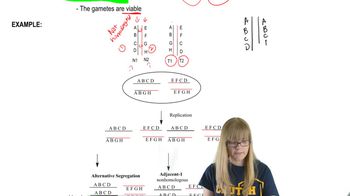How many chromosomes does a person who is a carrier for familial down syndrome caused by a robertsonian translocation have?
Table of contents
- 1. Introduction to Genetics51m
- 2. Mendel's Laws of Inheritance3h 37m
- 3. Extensions to Mendelian Inheritance2h 41m
- 4. Genetic Mapping and Linkage2h 28m
- 5. Genetics of Bacteria and Viruses1h 21m
- 6. Chromosomal Variation1h 48m
- 7. DNA and Chromosome Structure56m
- 8. DNA Replication1h 10m
- 9. Mitosis and Meiosis1h 34m
- 10. Transcription1h 0m
- 11. Translation58m
- 12. Gene Regulation in Prokaryotes1h 19m
- 13. Gene Regulation in Eukaryotes44m
- 14. Genetic Control of Development44m
- 15. Genomes and Genomics1h 50m
- 16. Transposable Elements47m
- 17. Mutation, Repair, and Recombination1h 6m
- 18. Molecular Genetic Tools19m
- 19. Cancer Genetics29m
- 20. Quantitative Genetics1h 26m
- 21. Population Genetics50m
- 22. Evolutionary Genetics29m
6. Chromosomal Variation
Chromosomal Rearrangements: Translocations
Problem 13c
Textbook Question
An animal heterozygous for a reciprocal balanced translocation has the following chromosomes:
MN • OPQRST
MN • OPQRjkl
cdef • ghijkl
cdef • ghiST
Identify the gametes produced by adjacent-1 segregation. Which, if any, of these gametes are viable?
 Verified step by step guidance
Verified step by step guidance1
Understand the problem: The animal is heterozygous for a reciprocal balanced translocation, meaning two non-homologous chromosomes have exchanged segments. The chromosomes involved are MN • OPQRST, MN • OPQRjkl, cdef • ghijkl, and cdef • ghiST. The task is to identify the gametes produced by adjacent-1 segregation and determine their viability.
Recall the concept of adjacent-1 segregation: In adjacent-1 segregation, homologous centromeres segregate to opposite poles during meiosis. This results in gametes that contain one chromosome from each translocation pair, but these chromosomes are not complementary. This often leads to unbalanced gametes.
Determine the gametes produced: To identify the gametes, pair the chromosomes such that homologous centromeres segregate to opposite poles. For example, one gamete might contain MN • OPQRST and cdef • ghiST, while another might contain MN • OPQRjkl and cdef • ghijkl. Repeat this process to identify all possible combinations.
Assess the viability of the gametes: Viability depends on whether the gametes are balanced or unbalanced. Balanced gametes contain a complete set of genetic information, while unbalanced gametes have duplications or deletions of genetic material. Analyze each gamete to determine if it has duplications or deletions by comparing the segments present in each chromosome.
Conclude the analysis: Summarize which gametes are produced by adjacent-1 segregation and indicate their viability based on the presence or absence of genetic imbalances. Balanced gametes are typically viable, while unbalanced gametes are usually inviable due to missing or extra genetic material.
 Verified video answer for a similar problem:
Verified video answer for a similar problem:This video solution was recommended by our tutors as helpful for the problem above
Video duration:
1mPlay a video:
Was this helpful?
Key Concepts
Here are the essential concepts you must grasp in order to answer the question correctly.
Reciprocal Balanced Translocation
A reciprocal balanced translocation occurs when two chromosomes exchange segments without any loss of genetic material. This results in a rearrangement of genes but maintains the overall genetic balance. In organisms with such translocations, the chromosomes can pair during meiosis, leading to unique segregation patterns that can affect gamete viability.
Recommended video:
Guided course

Reciprocal Translocation
Adjacent-1 Segregation
Adjacent-1 segregation is a specific way chromosomes can segregate during meiosis in individuals with reciprocal translocations. In this process, one chromosome from each pair of homologous chromosomes is selected, leading to gametes that contain both segments from one translocated chromosome and none from the other. This often results in gametes that are unbalanced and typically non-viable.
Recommended video:
Guided course

Reciprocal Translocation
Gamete Viability
Gamete viability refers to the ability of gametes to develop into a viable organism after fertilization. In the context of adjacent-1 segregation, the resulting gametes may have an unbalanced set of chromosomes, which often leads to developmental issues or lethality. Understanding which gametes are viable is crucial for predicting the outcomes of genetic crosses involving translocations.
Recommended video:
Guided course

Gamete Development

 12:42m
12:42mWatch next
Master Reciprocal Translocation with a bite sized video explanation from Kylia
Start learningRelated Videos
Related Practice
Multiple Choice
530
views
1
rank
